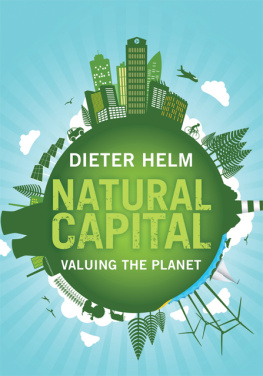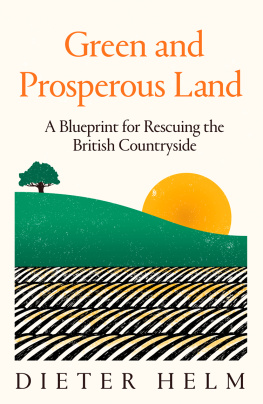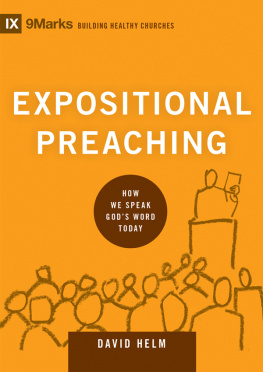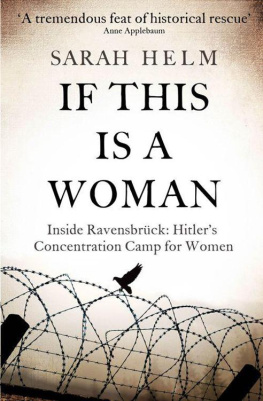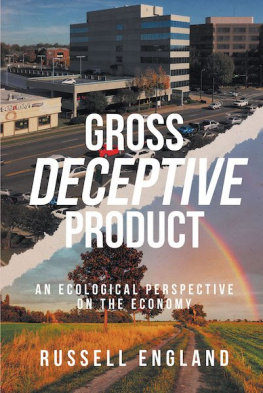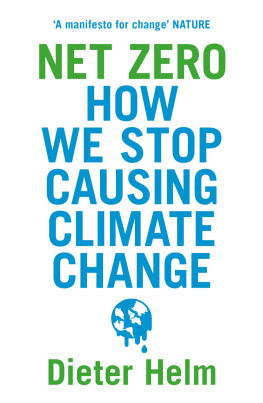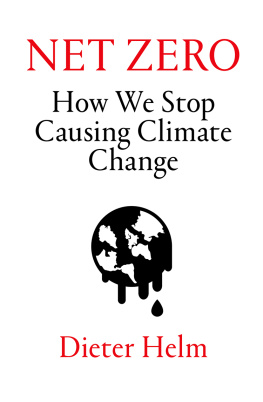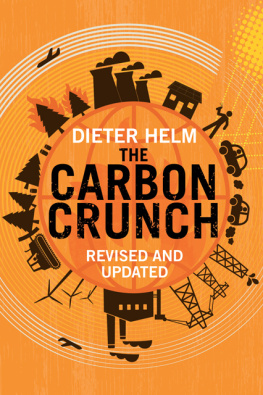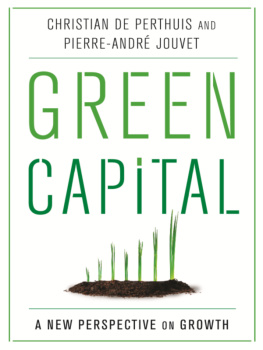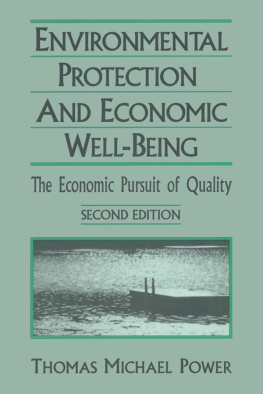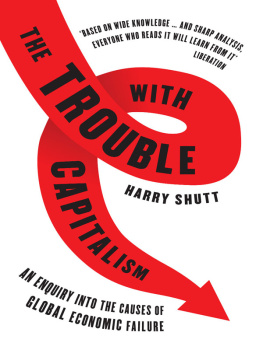
For Sue, Oliver and Laura

Copyright 2015 Dieter Helm
The right of Dieter Helm to be identified as author of this work has been asserted by him in accordance with the Copyright, Designs and Patents Act 1988.
All rights reserved. This book may not be reproduced in whole or in part, in any form (beyond that copying permitted by Sections 107 and 108 of the U.S. Copyright Law and except by reviewers for the public press) without written permission from the publishers.
For information about this and other Yale University Press publications, please contact:
U.S. Office:
Europe Office:
Set in Minion Pro by IDSUK (DataConnection) Ltd
Printed in Great Britain by TJ International Ltd, Padstow, Cornwall
Library of Congress Control Number: 2015936735
ISBN 978-0-300-21098-9
A catalogue record for this book is available from the British Library.
10 9 8 7 6 5 4 3 2 1
Contents
Preface and Acknowledgements
There is nothing new about the destruction of our natural environment. It is well known, and well documented so much so that it has become a part of our culture and literature. Wordsworths poems about the violence that humans bring to nature and the threats to his beloved Lake District, and Henry David Thoreaus Walden Pond, link through to Rachel Carsons Silent Spring.
Scientists have measured what poets have lamented. With the coming of satellite technology and the digitalization of just about everything, the destruction cannot be hidden from public view. When E. O. Wilson noted the progress of what he termed in The Diversity of Life the sixth great extinction in geological history, even he may have underestimated what is coming. We may not know how many species there are, and we probably never will, but the pace of decline for what we can and have measured is all too apparent.
What nature, and the natural capital embedded in it, now confronts in this century is on a new and completely different scale. If the worlds economic growth carries on along the current path, and the world economy expands at around 34 per cent per annum, then it will be a staggering 16 times bigger than it is now by the end of this century. China alone on its current growth rates doubles in size every decade. It is almost impossible to imagine what this world will be like.
This book is not primarily about the scale of the challenge. This will largely be taken as a given. The focus here is on why this destruction takes place, and how it can be moderated, stopped and eventually reversed. Doom and gloom make good headlines, but they do not get us very far. Understanding why things are going so badly wrong helps to identify how to put them right.
The central argument of this book is that only by putting the environment at the heart of the economy can there be much hope of addressing the scale of the destruction that will otherwise happen. It is perfectly possible to achieve sustainable economic growth. The prize is great, and it can be financed. The loss of biodiversity and much of our natural environment may be a physical and biological process, but the solutions lie squarely in the allocation of scarce resources in other words, with economics.
Economic growth does not have to be abandoned to improve the state of natural capital. It just has to be sustainable economic growth, not the sort of growth currently so widely promoted. The way economies and narrow economic growth have been measured and promoted has much to do with why nature is in such a poor state. In rethinking the economics of natural capital, and properly incorporating it into the economy, solutions can be found.
It is easy to get angry at the failure to stop the rot and capture the considerable economic benefits from enhancing natural capital, especially when there are immediate and practical measures that can and should be taken. I have had the privilege of chairing the Natural Capital Committee since 2012, when it was set up to start to address some of these failures. It is the first such committee in the world, and hence the way it addresses the natural capital issues in its particular national context provides an example for other countries contemplating a similar path.
Though there are many areas where different approaches can be taken and assessments made, my fellow committee members have all influenced me enormously and I am very grateful to them. Each has made a major contribution to understanding natural capital generally. Giles Atkinsons understanding of sustainability and international accounting, together with Colin Mayers deep knowledge of finance and accounting, Kerry ten Kates understanding of the corporate and international dimensions, Ian Batemans mastery of costbenefit analysis, Georgina Maces research on the science of biodiversity, Rosie Hailss practical understanding of ecology, and Robin Smales work on specific environmental policy issues and the key players comprise a formidable bank of expertise on which I have been able to draw. The Natural Capital Committees secretariat has been led by remarkable individuals, notably Nick Barter and Julian Harlow. It should, of course, be stressed that none of these colleagues is responsible for my errors, and nothing in this book should be ascribed to the Natural Capital Committee or to any of its members. The Committees views are presented in its key papers, notably the three State of Natural Capital annual reports (to be found on its website).
I also have the privilege of being a Vice President of Berkshire, Buckinghamshire and Oxfordshire Wildlife Trust (BBOWT). Conversations with Hugh Mellor, Clive Booth, Philippa Lyons and Estelle Bailey of the Trust over the years have influenced my thinking, as have the extraordinary work and commitment of its staff and volunteers. Discussions over the years with those running the great environmental trusts and organizations including Simon Jenkins and Helen Ghosh at the National Trust, Mike Clarke at the Royal Society for the Protection of Birds (RSPB), Shaun Spiers at the Campaign to Protect Rural England and Stephanie Hilborne at The Wildlife Trusts have also helped shape my views. John Bennett at the Kent Wildlife Trust and Simon Nash from the Somerset Wildlife Trust have helped with some of the examples in this book.
I have greatly benefited from the contributions to the Natural Capital Seminars, which I have co-chaired with Cameron Hepburn and Bob Hahn at the Smith School of Enterprise and the Environment at Oxford, under the impressive leadership of Gordon Clark. Kathy Willis and Ian Boyd in particular have shaped some of my thinking. Nature in the Balance, which I co-edited with Cameron Hepburn, brought together a number of the worlds leading environmental economists, and several papers are echoed in this book. Ed Barbier has been pioneering in his work on natural capital, and the contributions by Kirk Hamilton and Chuck Mason have been profound. I have benefited from conversations with all three of them.
A number of colleagues have commented on various drafts. I am particularly grateful to Cameron Hepburn, Charles Godfray, and (again) to Stephanie Hilborne and Julian Harlow for their critical assessments and saving me from errors I would otherwise have made. I am also grateful to Matt Jackson of BBOWT for his very helpful comments. Again, none is responsible for my errors.
Though there are major global dimensions to natural capital, our experience of nature and natural capital is inevitably local. It is part of what gives us a sense of place and identity. Each has his or her own special places, be it an urban park, such as Central Park in New York, a playing field, a favourite beach or a wild landscape. For me, these include the Upper Thames (where I live), the lochs and sea pools of North Uist in the Outer Hebrides off the west coast of Scotland, the rivers and moorlands of Exmoor in the south-west of England, and the Isles of Scilly off the coast of Cornwall. It is therefore no accident that these provide some of the examples in this book. Readers will have their own special places, and the concepts developed here can be read across from my necessarily local examples to their own contexts.
Next page
